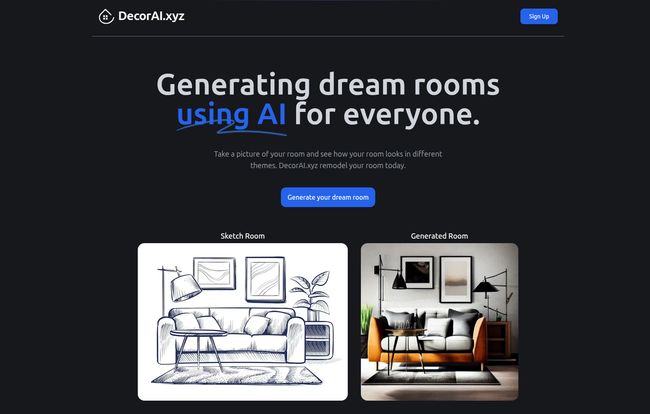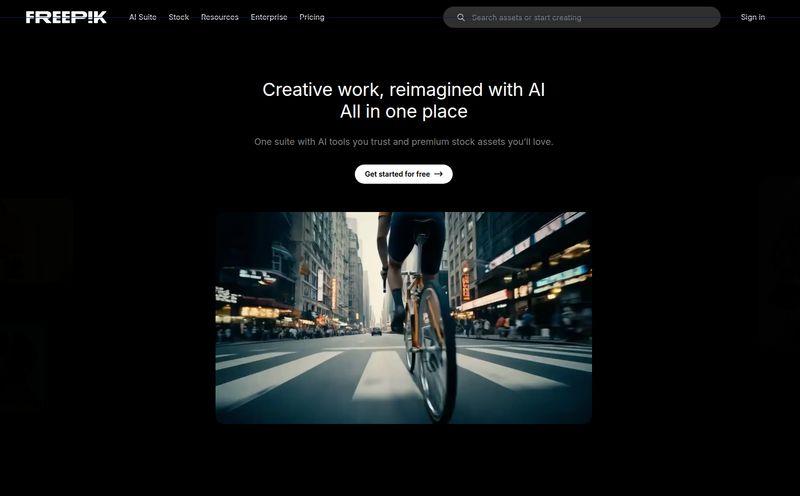Most of us have a room we're not proud of. You know the one. Maybe it's the spare bedroom that’s become a graveyard for forgotten hobbies, or the living room that still has the same layout from when you moved in five years ago. My nemesis? The home office. It was… functional. A desk, a chair, a sad-looking plant. It screamed “I get work done here” but whispered “I have zero personality.”
For years, I've told myself I’d hire an interior designer. But then I'd look at the prices—we're talking thousands of dollars—and my wallet would physically recoil. I'd spend hours scrolling through Pinterest, getting overwhelmed by a million different aesthetics, and end up doing absolutely nothing. A classic case of analysis paralysis.
Then I stumbled upon DecorAI. The promise was simple: use artificial intelligence to generate dream rooms from a simple photo. My inner tech geek was intrigued, and my inner cheapskate was practically screaming. An AI that could do a designer's job for the price of a few fancy coffees a month? Okay, you have my attention.
So, What Exactly is DecorAI?
Think of it like this: DecorAI is an interior designer on speed dial, but one that lives in your computer and doesn't judge you for wanting to see what a “Cyberpunk” themed bathroom looks like. At its core, it’s an AI-powered platform where you upload a picture of your space—or even a crude sketch, which is wild—and it completely reimagines it based on styles you select.
It’s not just slapping a new coat of paint on the walls, either. The tool reconfigures furniture, changes lighting, adds decor, and transforms the entire vibe of the room. It's built on a massive dataset of over 160 million images, so its frame of reference is bigger than pretty much any human's. It's designed for regular people—homeowners, renters who want to convince their landlord to let them paint, and even small businesses trying to spruce up an office or cafe without breaking the bank.
My First Brush with DecorAI’s Magic Wand
Naturally, I had to put my sad little office to the test. The process was ridiculously simple. I snapped a quick, poorly lit photo with my phone—no professional staging here—and uploaded it to the platform.

Visit DecorAI
Then came the fun part. The styles. There were dozens to choose from. Minimalist, Industrial, Bohemian, Art Deco… you name it. For my first go, I picked “Modern.” I hit the generate button, and within what felt like 30 seconds, I had a handful of new designs. And I have to say, my jaw dropped a little. My cluttered, uninspired office was suddenly a sleek, stylish workspace. One version had a beautiful built-in bookshelf, another a chic accent wall. It was the same room, same bones, but it had potential. It felt like one of those home makeover shows, but without the tearful backstory.
The best part? It broke me out of my creative rut. I suddenly saw possibilities I’d never considered. Maybe that wall would look good in a dark, moody color. Maybe I do need a funky armchair in the corner. It's one thing to see a cool room on Pinterest; it's another to see a cool version of your own room.
The Features That Actually Matter
After playing around for a while, a few features really stood out to me as being more than just gimmicks. They're genuinely useful tools in the design process.
From Napkin Sketch to Photorealistic Room
This one is for all the visionaries who can't draw. The sketch-to-photo feature is incredible. You can literally draw a basic layout—a few boxes for a sofa, a circle for a table—and DecorAI will interpret it and generate a realistic-looking room. This is a game-changer for people who are starting from scratch, like with an empty room or a new build. It helps you visualize a layout before you even own a single piece of furniture. Honestly, its impressive.
Customizing Your Virtual World
While the initial generation is cool, the ability to tweak things is where it gets powerful. The tool allows you to add custom furniture to your designs. So if you find a specific sofa online, you can conceptually see how it might fit into the AI-generated space. This bridges the gap between digital fantasy and real-world shopping. You can keep iterating, swapping things in and out, until you land on something you not only love but can actually create.
Getting a Clearer Picture with Upscaling
Sometimes the initial AI renders can be a little… dreamy. A bit fuzzy around the edges. DecorAI includes a 4x image upscaler. With a click, it sharpens the image, bringing out the textures and details. This is super important when you're trying to see the subtle patterns on a rug or the grain of a wood finish. For anyone trying to create a serious design plan, this high-resolution output is non-negotiable.
Who Should Be Using DecorAI? (And Who Can Skip It?)
So, who is this for? Based on my experience, I see a few key groups getting a ton of value here.
- Homeowners: This is the most obvious group. If you're stuck in a design rut, planning a renovation, or just want to refresh a room, this tool is your new best friend. It’s a fantastic way to experiment without risk.
- Renters: Often limited by what they can change, renters can use DecorAI to visualize how furniture, decor, and non-permanent changes (like rugs and lighting) can completely transform a space. It can even help you make a case to your landlord for bigger changes by showing them a professional-looking concept.
- Small Businesses & Realtors: I'm looking at this with my SEO and business hat on now. Realtors can use it for virtual staging, turning photos of empty listings into warm, inviting homes. Small business owners can design their cafe, shop, or office on a shoestring budget. The included commercial license is a massive bonus here.
Who should pass? If you're doing a major structural renovation that involves moving walls or plumbing, you'll still need an architect or contractor. This is a tool for interior design, not architecture. Also, if you're after a truly one-of-a-kind, avant-garde design from a world-renowned designer with a specific human touch, this AI might feel a bit too polished. But for the other 99% of us, it's pretty spot on.
Let's Talk Money: The DecorAI Price Tag
Alright, the all-important question: what's the damage? I was pleasantly surprised here. It's a subscription model, which makes sense for a tool with ongoing server costs. Here's how it breaks down:
| Plan | Cost | Billing Cycle | Key Features |
|---|---|---|---|
| Monthly | $24 | Per Month | Unlimited Renders, 4x Upscaling, Privacy, Commercial License |
| Half-Yearly | $120 | Every 6 Months | Same as Monthly + 1 Month Free |
| Yearly | $240 | Per Year | Same as Monthly + 2 Months Free |
When you compare a $24 monthly fee to the $1,000+ starting price for a human designer, the value is obvious. For the cost of a single consultation hour with a traditional designer, you can get a whole year of unlimited designs with DecorAI. For me, the yearly plan offers the best bang for your buck if you know you'll be working on a few projects.
The Good and The Not-So-Good
No tool is perfect, right? Here's my honest breakdown.
What I Loved: The speed is just phenomenal. Going from idea to visual concept in under a minute feels like science fiction. The sheer variety of styles pushes you to think outside your comfort zone. It's incredibly easy to use; there’s virtually no learning curve. And the cost-effectiveness is, without a doubt, its biggest selling point.
What Could Be Better: The main drawback is the lack of a free trial. I really wish they offered a few free renders to let people test the waters before committing. I get it, AI processing costs money, but it’s a barrier for some. You have to be willing to drop the $24 to even try it. Also, while the AI is brilliant, it can't have a conversation with you about your lifestyle or how your family uses the space—that human element is still something only a person can provide.
Final Thoughts: Is DecorAI a Gimmick or a Game-Changer?
After turning my office from a beige box into dozens of potential dream spaces, I’m a believer. DecorAI isn't here to replace high-end interior designers. It’s here to democratize design for the rest of us. It’s a tool that empowers you to take control of your own space, to experiment freely, and to find a style that truly feels like you.
It’s a creative partner that helps you overcome the fear of the blank canvas. For homeowners feeling stuck, renters wanting to personalize their space, or small businesses on a budget, it’s not just a cool piece of tech—it's a genuinely useful, cost-effective solution. It turned my design dread into design excitement, and for $24, that’s a pretty great deal.
Frequently Asked Questions
- How does DecorAI actually work?
- It uses a sophisticated AI trained on millions of images. You provide a photo or sketch of your room, and the AI analyzes the layout, dimensions, and lighting. Then, based on the style you select, it generates a new image showing a redesigned version of your space.
- Is there a free trial for DecorAI?
- Unfortunately, no. DecorAI currently operates on a subscription-only model. You need to sign up for a monthly, half-yearly, or yearly plan to start generating designs.
- Can I use the designs for my business?
- Yes, you can! All of the paid plans come with a commercial usage license. This is a fantastic feature for real estate agents, small business owners, or content creators who need design visuals.
- Do I need any design skills to use it?
- Absolutely not. The platform is designed to be incredibly user-friendly. If you can upload a photo and click a button, you can use DecorAI. It’s made for beginners and people who don’t have an “eye for design.”
- What kind of styles can it generate?
- There's a wide variety, including popular choices like Modern, Minimalist, Scandinavian, Bohemian, Industrial, and Rustic, as well as more niche or fun styles to experiment with.
- How much does DecorAI cost per month?
- The monthly plan is $24. You can get a lower effective monthly rate by opting for the half-yearly plan at $120 or the yearly plan at $240.


